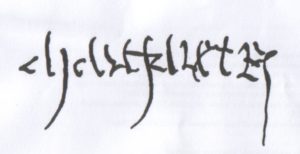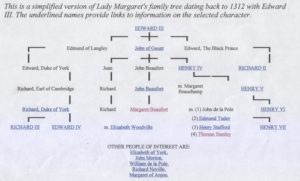by Diane Johnson
The most beautiful & impressive building in Mold is the parish church of St Mary’s, situated on the high ground at the upper end of the High Street. This magnificent church, with the exception of some Victorian embellishments, dates from the late fifteenth to early sixteenth centuries as evidenced by its Perpendicular style of architecture.
This is not the first church on this site. There is evidence, in the form of its large circular churchyard, that the church could have come into existence in the early medieval period. This was before the Norman lords of Moldsdale, the Monalts, occupied the nearby hill top where they built their motte & bailey castle. They may have endowed this church themselves & the dedication to St Mary may also have been made at this time, superseding an earlier British or Welsh one.
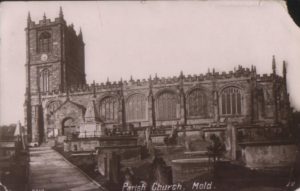 The records from the Norwich Taxation of Ecclesiastical Property show that there was some form of church in Mold in 1253 when “Kendric” is mentioned as Rural Dean.
The records from the Norwich Taxation of Ecclesiastical Property show that there was some form of church in Mold in 1253 when “Kendric” is mentioned as Rural Dean.
In the Lincoln Taxation of 1291, there is mention of a church of Mont Alto with the Chapelry of Nerquis. It was valued at £43 –a huge sum, making it the second richest church in north & mid Wales. This wealth might indicate that it was an old established foundation, having developed as a mother church in the region with its dependent chapelries.
Another reference to the existence of the church can be found in the “Llyr Coch” (Red Book of St Asaph) where the institution of a priest to the Rectory of Monte Alto is recorded in 1318.
In 1329, Robert de Monalt, Lord of Hawarden & Mold died without issue. The lordship passed to Queen Isabella of France, wife of Edward II. However she conspired against her husband & her son, Edward III, confiscated her lands. He granted “the castle and manor of Hawardyn, the castle and town of Mold, and the advowson of the church of Mold ”etc to his supporter, William Montacute, Earl of Salisbury, in 1337. This family founded the Augustinian monastery of Bisham in Berkshire & the rectory of Mold was appropriated & attached to this foundation, with certain reservations to the Bishop of St Asaph.
Practically nothing of this earlier church remains although the fourteenth century tower did serve the new building until the middle of the eighteenth century when the present one was erected. Traces of medieval carving, attributed to possibly the late twelfth century to the late fifteenth century, can be seen set in a wall close to the church. It is thought likely that they are the remnants of the earlier church building.
This was the church that was replaced by the magnificent structure that we see today. Why this rebuilding was undertaken & who was responsible for it, takes us to the heart of the new Tudor dynasty & its court – the court of Henry VII.
We can identify from the abundance of heraldic devices throughout the interior of the church, the personages who were responsible for the rebuild – Margaret Beaufort, mother of Henry VII & her third husband, Thomas Stanley, who at that time was Lord of Mold. These emblems include the portcullis of Margaret Beaufort, the eagle & claw, the pelican & the legs of Man of the Stanleys & they can be seen on carvings & in the remaining fragments of stained glass.
Throughout the fifteenth century the War of the Rose raged throughout England & Wales between opposing Yorkist & Lancastrian claimants to the throne. Both Margaret Beaufort & the Stanleys played an important role in the final outcome when Henry Tudor, a Lancastrian, fought & defeated the last Yorkist king, Richard III at the Battle of Bosworth in 1485. Henry’s claim to the throne came from his mother’s descent from John of Gaunt, third son of Edward III.
LADY MARGARET BEAUFORT (Part I 1441-1485)
Margaret’s Signature
Margaret’s father was descended from John of Gaunt, duke of Lancaster (1340-99), & his adulterous liaison with his mistress Katherine Swynford. The children resulting from this relationship were given the name Beaufort after Gaunt’s castle & lordship in Champagne in France. Although Gaunt openly acknowledged these children & treated them fairly his main interest lay with his legitimate heir, Henry of Bolingbroke. However, he saw to it that these illegitimate children made suitable marriages to well-to-do gentry. 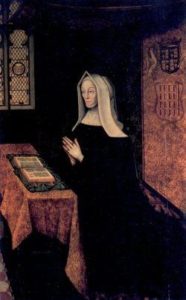
Margaret’s grandfather was the eldest of these children, John Beaufort, later Earl of Somerset.
After the death of his second wife Johnof Gaunt married Katherine Swynford in 1396. The couple immediately petitioned the pope to secure its confirmation, in view of the adulterous relationship they had enjoyed during Gaunt’s second marriage. The pope did ratify the marriage & declared its offspring, past as well as future legitimate. However, this only meant that the church recognised their claim; it did not enable them to succeed to properties etc. To rectify this Gaunt had their legitimacy confirmed by act of parliament & this enabled them to attain diginities & offices as if they were born in lawful matrimony. Immediately Margaret’s grandfather was created Earl of Somerset & was granted many honours. A prestigious marriage was secured for him with Richard II’s niece , Margaret Holland . This lady became the co-heiress of Edmund of Kent & this in turn led to Margaret Beaufort becoming a very wealthy heiress.
Even in the face of all this acknowledged legitimacy there were still doubts over the status of John Beaufort as a considerable length of time had elapsed between his birth & the marriage of his parents. These aspects were to leave a taint that the process of legitimation could not completely remove. During the reign of Henry IV in 1407, John Beaufort petitioned the king requesting clarification of his position regarding the original letter patent of 1397 as it conferred no royal interest or right or title to the throne. The royal response was the confirmation of the original letters. Hence they could not inherit the throne.
This did not stop Beaufort being loyal to the Lancastrian royal house & from 1401 he was the magnate closest to the king until he died in 1410. His brother Henry Beaufort, the great bishop & cardinal was one of the chief rulers of England during the weak rule of Henry VI.
Margaret’s father, another John Beaufort, duke of Somerset, as a young man was engaged in the French Wars & as such was captured at the Battle of Bauge. He remained as captive there for the next seventeen years. After complex negotiations he was finally given his freedom in 1438 but the paying off of his ransom was to encumber him for the rest of life. After his return he married Margaret Beauchamp of Bletsoe in 1442, a lady “right noble as well in manners as in blood”.
He was given another chance to lead another expedition to France but this was not successful & he retired to the west country where he died in disgrace shortly afterwards in 1444.
Margaret had been born on May 31, 1443 & was less than two years old when her father died. She continued to live with her mother at Bletsoe castle (Beds) but under the wardship of the very powerful William de la Pole, earl of Suffolk. The business of allocating wardships of the children of the aristocracy until they came of age was in the gift of the king. This entitled the holder to run the child’s estates & garner the revenues therefrom. A very lucrative position to hold. Suffolk was an influential & ambitious figure at the Lancastrian court & he was able to use his position at court to obtain a number of profitable wardships.
At the age of seven or eight Margaret was bethrothed to Suffollk’s son, John de la Pole in 1450.However, later that year Suffolk was accused of treason & executed. The marriage was dissolved three years later.
Whilst all this was going on, she remained in the care of her mother where she was given a very good education. T
There was already a tradition amongst the Beaufort women of “higher education” & it is believed that her great-aunts were the first ladies in England who learnt to write. She had a very good knowledge of French & some Latin but above all she was taught to be a good Christian & devoted daughter of the church. This piety remained with her for the rest of her life.
After the dissolution of her marriage to John de la Pole in 1453, it fell to the king to award her wardship & marriage to whoever he chose. This time he appointed his own half-brothers, Jasper & Edmund Tudor.
The Tudors
The founder of the Tudor family was Ednyfed Fychan, seneschal to the Princes of Gwynedd in the thirteenth century. His sons served Llewelyn ap Gruffydd, the last independent prince of Wales in the same capacity. After the fall of the House of Gwynedd they managed to avoid disaster, maybe by becoming supporters of the English Crown & they became a typical prosperous gentry family of that time. At the beginning of the fifteenth century the family became involved in the Glyn Dwr rebellion & had their lands confiscated. One of the Tudors, Rhys, is believed to have been executed at Chester in 1412. Another of the family, Maredudd is thought to have fled Wales as the result of some crime or other & possibly found haven at the English court. His son Owen became a page & squire to Henry V & anglicised his name to Tudor.
Henry V, son of Henry IV, the famous hero of Agincourt, died a young man in 1422 at the age of 35. He had married Catherine de Valois of France & they had one son who became Edward VI.
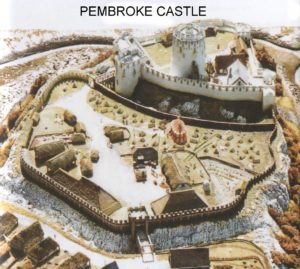 Owen & the widowed Catherine formed a liaison & it is not definitely recorded as to whether they actually became legally married. They had four children, three sons & one daughter who died in infancy. They were the King’s half brothers & as such were formally brought into the royal family by HenryVI. In 1452 Edmund was created Earl of Richmond & Jasper, Earl of Pembroke. (The other son had become a monk). They were generously endowed with lands & other honours.
Owen & the widowed Catherine formed a liaison & it is not definitely recorded as to whether they actually became legally married. They had four children, three sons & one daughter who died in infancy. They were the King’s half brothers & as such were formally brought into the royal family by HenryVI. In 1452 Edmund was created Earl of Richmond & Jasper, Earl of Pembroke. (The other son had become a monk). They were generously endowed with lands & other honours.
The king decreed that the Edmund Tudor would marry Margaret Beaufort & this marriage took place either in 1454 or 55. There were sound dynastic reasons for arranging this match as it gave Edmund Tudor a claim to the throne through his wife’s Lancastrian blood. However, this proved unnecessary with the birth of Henry’s son, Edward in 1453.
This marriage between the very young Margaret (a twelve year old) & Edmund was brief. The couple had travelled to south Wales in the autumn of 1455, taking up residence at Lamphey in Pembrokeshire Unfortunately, Edmund in his position as Henry VI’s lieutenant in the region, during some fighting was captured & imprisoned in Carmarthen Castle by some Yorkists. He was released but in November 1456 he succumbed to an outbreak of plague & died. His young widow at this time was six months pregnant. She was now given protection by Edmund’s brother, Jasper, & taken to his castle of Pembroke. It was here that she gave birth, on the 28th January 1457 to her son, the future Henry VII. Apparently it was a very difficult birth & possibly she sustained some physical damage as she was never able to bear any further children with either of her subsequent husbands. Thus as her only child, the bonds between mother & son were very strong & she was always in the fore front of putting forward his dynastic claims.
The Wars of the Roses
By the mid fifteenth century, the struggle that was to become known as the War of the Roses was very fraught. This conflict was the result of the rivalry between the House of York (the white rose) & the House of Lancaster (the red rose) for the throne of England. The seeds for it had been sown in 1399 when the son of John of Gaunt, Henry Bolingbroke had seized the throne from the weak Richard II. [Richard had been captured at Flint Castle]. Bolingbroke became Henry VI & his reign was an unstable one, with uprisings & revolts from rebel lords.
His son, Henry V, crowned in 1413 was a warrior & found lasting fame for his victory at Agincourt against the French in 1415. However, as seen earlier he died a young man & the throne passed to his son who became Henry VI in 1422.
Henry VI was not in the same mould as his father, was not warlike & is mainly remembered for being unworldly & foolish, although he had a saintlike devotion to God & the Church. He lacked the regal attributes that the times demanded & his reign was beset by the power struggles over the succession. There was no heir until 1453 & the Dukes of York & Somerset ( Margaret’s uncle, who on the death of her father had taken on the role of head of the family) both had an eye on the throne. It was essentially this conflict between these two magnates that sparked the Wars of the Roses. As the authority of the king was undermined by his mental stability, both sides vied for power & this ultimately resulted in the first Battle of St Albans where the Yorkist force defeated the king & Somerset was killed. This gave the Yorkists control of the king. However this did not end the conflict as Henry VI’s wife, Margaret of Anjou, took up the fight & many years of civil war began, with the fortunes of both sides waxing & waning at different times. The matter was finally resolved thirty years later at Bosworth.
This was the political background to Margaret’s childhood & subsequent marriage. The importance of her son in the dynastic struggle was something that she devoted her life to protecting, especially in view of the fact that many of her relations & those with whom she connections were being killed during this armed conflict.
After the death of Edmund Tudor, another match was made for her within a short period of time; her second husband was to be Henry Stafford, the second son of the Duke of Buckingham. This time she played an active role in her own future. Buckingham was a very powerful magnate & she could rely on him to protect both her own & her son’s fortunes. They were probably married in January 1458.
Over the next few years Stafford supported the Lancastrian cause but after the Yorkist victory at Towton in 1461, after which Henry VI & his wife escaped to Scotland, Edward IV, the Yorkist claimant, was crowned. Stafford made peace with the new regime & secured a pardon for himself & later for his wife. This protected Margaret’s estates but the price paid was the long-term separation of mother & son as one of Edward IV’s supporters, William Lord Herbert, was awarded the wardship of Henry Tudor. It was at Raglan Castle under the care of Herbert’s wife, Anne Devereux, that Henry spent most of his childhood.
Over the rest of her marriage to Stafford, she supported him as he gained favour at the Yorkist court. Edward had no reason to complain about their loyalty.
It is believed that the Staffords lived for some years principally at Woking but spent time in London & in visiting their distant properties seeing to their administration. She cultivated her interest in learning & it was said of her that she was “right studious in her books”.
This was not the only problems besetting Margaret as her husband Stafford died in October 1471. However her widowhood was not to last for long for within the prescribed year of mourning she married Thomas Lord Stanley. In 1469-1471, the country entered a period of great instability when the great Earl of Warwick ( called “the kingmaker”) rebelled against |the king. This insurrection caused a great deal of turmoil for 2 years & it was at the Battle of Tewkesbury in 1471 that the Lancastrians were defeated by Edward. The Yorkists were to hold on to the throne for the next fourteen years. At Tewkesbury, Henry VI’s son & Lancastrian heir was killed. This meant that the person with the strongest claim on the Lancastrian side was Henry Tudor & Margaret feared for his safety. Henry Tudor was with Jasper Tudor at Pembroke Castle, defending it against the Yorkists. Margaret advised them to escape. They made their way to from the castle to Tenby & from there they set sail for France. This was the beginning of a long period of exile for Henry with a question mark hanging over his political future.
This is where the connection between Margaret Beaufort & Mold is made as Thomas Stanley held the lordship of Mold at this time.
 The Stanley family had risen to prominence in the fifteenth century through a combination of local influence, especially in Cheshire & Lancashire where they held vast estates & activity at court. Thomas Lord Stanley had been entrusted with the office of steward of the royal household during the second decade of Edward IV’s reign & had served the king loyally. As a reward, the king delegated to him considerable power in the north west.
The Stanley family had risen to prominence in the fifteenth century through a combination of local influence, especially in Cheshire & Lancashire where they held vast estates & activity at court. Thomas Lord Stanley had been entrusted with the office of steward of the royal household during the second decade of Edward IV’s reign & had served the king loyally. As a reward, the king delegated to him considerable power in the north west.
Marriage to this magnate offered Margaret protection & an enhanced influence at the Yorkist court. The marriage contract guaranteed her an income from Stanley’s estates in Cheshire & north Wales –a connection with Mold?
In return Stanley was able to expand his territorial influence in the Midlands & the south of England.
The marriage took place at one of the Stanley Lancashire residences, possibly Knowsley Hall near Liverpool in June 1472. This Hall was enlarged to provide Margaret’s household officers with a permanentplace of residence. The couple were always on the move, visiting the court & also attending to all their disparate estates. We have record of their visits to this part of the world when they resided at Hawarden castle & saw to the administration of this area.
This strong alliance to the Yorkist court enabled Margaret to work for the rehabilitation of her son with Edward. This was certainly making progress with Edward looking favourably on Henry Tudor being made heir to Margaret’s west country lands. This arrangement was made in a document which described “ certain appointements & agreementsmade in the highe presensof oure soveraigne Lorde” in 1482. Also Henry was granted a large portion of his recently deceased grandmother’s estates upon certain conditions. The principal was that Henry was to return from exile , “to be in the grace & favour of the King’s highness”.
This was a remarkable achievement & was the fruit of the negotiations between Edward, Margaret & Stanley. There was also some talk of a marriage between Henry & Elizabeth, the daughter of Edward. This actually did come about but not till after Bosworth & Henry had become king.
Events changed for Henry as on 9 April 1483 Edward IV died. & Edward’s brother, Richard, Duke of Gloucester became Protector of the realm. This was necessary as both of Edward’s sons were not of age to accept the crown. However, Richard declared these sons illegitimate & accepted the Crown himself by proclamation & was duly crowned. The young princes were put into the Tower of London & were never seen again. (The mystery of the ‘Princes in the Tower’).
Margaret’s intention was to try & safeguard the arrangements she had made for her son with Edward so she tried to form an alliance with Richard & even played an important role at his coronation. As time went on there was deep resentment at what was perceived as Richard’s usurpation of the Crown & there was lot of hostility to him. Margaret sensed this & she abandoned her allegiance to Richard & became embroiled in the plotting against him in support of her son’s claim. All this plotting put her life in danger but the loyalty of Stanley to Richard saved her. She was spared attainder at the 1484 parliament,” remembering the good & faithful service that Thomas Lord Stanley hath doon”. However she did forfeit her right to all her lands & estates. This meant that Henry also lost any right to these lands. Stanley was instructed to keep his wife confined in some secret place without household servants. This did not stop Margaret from communicating with her son.
Eventually Henry, with his friends & supporters, did make a bid for the throne. In the summer of 1485 he fitted out a small fleet at Harfleur in France with the help of the French king.. He landed at Milford Haven where he was joined by his uncle, Jasper Tudor who had remained a staunch supporter all this time. They were well supported in Wales & had a sizeable force as they marched into the Midlands to confront Richard & his army.
The Stanleys were to play a pivotal role in what followed. Although Richard hoped they would remain loyal to him, he had his doubts. He even took Lord Stanley’s eldest son, Lord Strange, as hostage to try & evsure his loyalty.
The two armies met at Bosworth & the Stanleys held off from supporting either side until the last moment when they joined Henry thus ensuring victory. Richard himself was killed. Thus the victor could claim the crown. The story goes that Thomas Stanley supposedly retrieved the crown from a thorn bush & placed on his stepson’s head & saluted him as king. Thus a new era had begun with a new dynasty on the throne.
Henry could claim his right to the throne through his mother’s lineage by blood but the final outcome & his success was due in no small part to Margaret’s determination to see her son attain the highest office.
From now on she was known as “the King’s Mother” & she was recognised as a very important lady at court. Thomas Stanley was rewarded with earldom of Derby.
To give thanks to God for the victory at Bosworth, Margaret dedicated the rest of her life in endowing university colleges & churches. Mold, with the Stanley connection, falls into this group This is why we have such a grand building to admire to this day.
TO BE CONTINUED
Copyright of articles
published in Ystrad Alun lies with the Mold Civic Society and individual contributors.
Contents and opinions expressed therein
remains the responsibility of individual authors.
